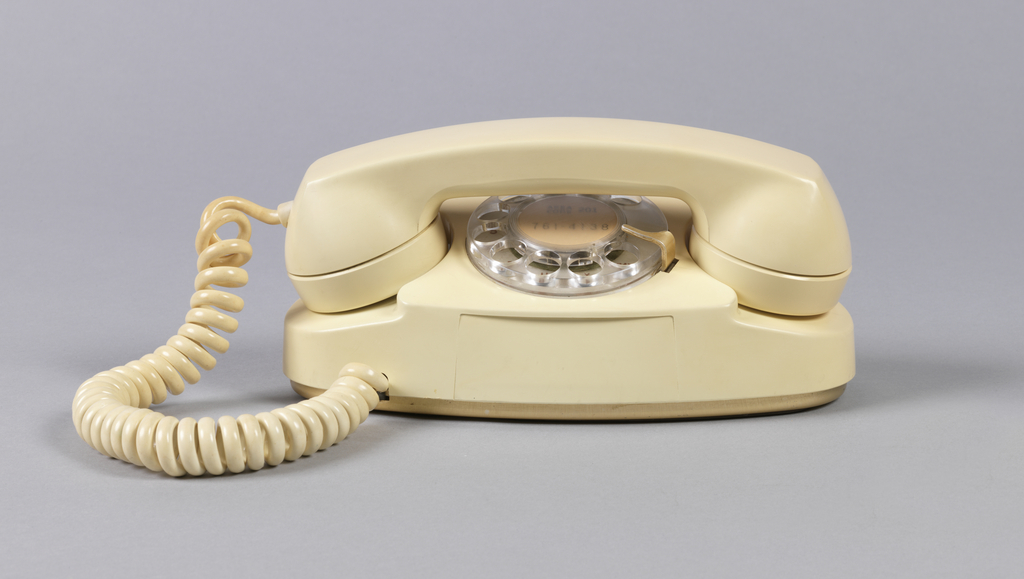The ubiquity of smart phones today makes it almost impossible to imagine a time when there were not many choices when purchasing a telephone, and they were not customizable, let alone portable. This began to change in 1959 when Bell Telephone Systems released the Princess telephone as the first phone specifically created for teenage girls and women. The Princess phone began a trend of using the telephone itself as a form of expression by taking a previously neutral communication device and transforming it into a gendered object. Described by its own advertising slogan “It’s little!…It’s lovely!…It lights!,” it is clear that this phone’s aesthetics were key. To appeal to the intended customers the Princess phone’s appearance was drastically different from previously successful telephone models such as the 500 series desk phone from 1949, and the wall model from 1956.
The Princess phone, as well as the other two aforementioned models, were all products of the design firm of Henry Dreyfuss. As one of the first celebrity industrial designers in America in the 1930s, Dreyfuss was responsible for creating objects ranging from clocks to locomotives throughout his career. The Princess phone’s handset firmly rests on its flat, ovoid base, and they blend together into a single form. The phone’s form is soft, curvy, and biomorphic. The shape of the phone was complimented by its pastel colors, with the phone originally available in white, beige, pink, blue and turquoise. The form is punctuated by its rotary dial, which lit up when the handset was lifted, so that the user could make calls in dim light or use it as a nightlight. This function, as well as the phone’s smaller size, indicates it's intended location of the bedroom, as well as suggesting that the phone is suited for use in personal, intimate situations. Overall the princess phone, in its beauty, and place in the home, was the embodiment of perfect womanly qualities of the time.
Despite the Princess phone’s stylish new look, there were issues with its operation. The phone was lightweight, but this attempt at convenience ultimately hindered the use of the phone because the base was too light and would move when the phone was dialed. Finally, the Princess phone did not come with an internal ringer so a separate one had to be purchased and mounted on the baseboard of a wall.[1] Despite the sexism inherent in the favoring of form over function, the formal design qualities of the Princess phone endured and were a stepping-stone to the Trimline phone released in 1965 that is still in production today. Compared to the unisex, yet endlessly adaptable phones available today, the Princess phone proves that we have come a long way.
Taylor Alvis is currently earning a M.A. in the History of Decorative Arts and Design at Parsons and is focusing her studies on popular culture and Scandinavian design.

2 thoughts on “Crossed Wires: The Gendered Technology of the Princess Phone”
Bob Daly retired Bell employee on September 8, 2019 at 11:07 pm
I was a telephone installer for ma bell for 40 years and I saw every type and model phone that was out public for many years.I must take a slight exception with your comments on the princess phone as the separate bell box came with it as did a small transformer to make the lights work.In later models the bell was in the phone and the transformer was no longer needed.
KATHY PATE on October 5, 2019 at 9:00 pm
My dad worked at C&P Telephone until January 29, 1962- while working his work truck was hit by a train, killing him, I was 6 years old at the time, it was the day b4 my brother’s birthday, needless to say it left us all devastated, I am to this day, I have sweet memories of him coming home for lunch & giving me & my friends the lil princess phones on the chain & the colorful wires used on the job that looked like rings, he was such a great man, I wish I had, had more time with him, I have been trying to find items as a tribute to him, especially a princess phone, I’ll know it when I see it, I hope it was ok I shared, thanks!